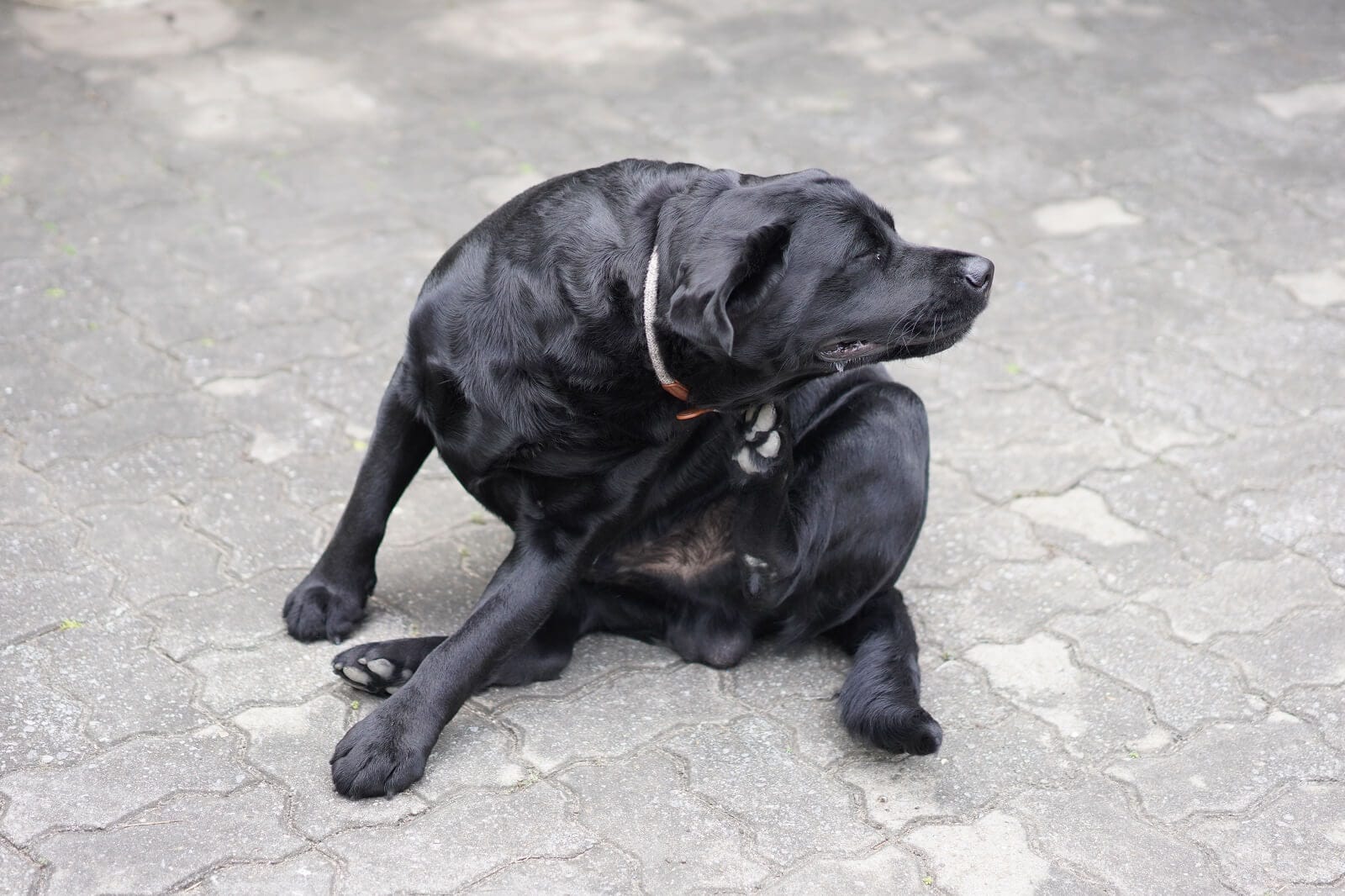Ant bites can be a common occurrence for dogs, especially when they are out in nature or playing in the backyard. These bites can cause discomfort and pain for the dog, and it is important for pet owners to know how to identify and treat them.

Ant bites on dogs can vary in severity depending on the type of ant and the dog's reaction to the bite. Some dogs may experience only mild symptoms such as redness and itching, while others may have a more severe reaction that includes swelling, hives, and even difficulty breathing. It is important to monitor your dog closely and seek veterinary care if you notice any concerning symptoms.
Prevention is key when it comes to ant bites on dogs. Pet owners can take steps to reduce the risk of their dog getting bitten by keeping their yard clean and free of ant hills, avoiding areas with known ant problems, and using ant repellents or natural remedies such as vinegar or citrus to keep ants away. By being aware of the risks and taking proactive measures, pet owners can help keep their furry friends safe and comfortable.

Identifying Ant Bites on Dogs
Ant bites on dogs can be a common occurrence, especially during the warmer months. Dog owners need to be able to identify ant bites on their pets to ensure proper treatment and care.
Ant bites on dogs can appear as small red bumps or welts on the skin. These bumps may be accompanied by itching, swelling, and pain. In some cases, dogs may also experience an allergic reaction to ant bites, which can cause more severe symptoms such as difficulty breathing and swelling of the face, mouth, or throat.
Dog owners should also be aware of the types of ants that are common in their area. Fire ants, for example, are known for their painful bites and aggressive behavior. They are often found in the southern United States and can be identified by their reddish-brown color and large mounds.
To help prevent ant bites on dogs, it is important to keep your yard and outdoor areas free of ant colonies. Regularly inspecting your dog's skin for bites and promptly treating any bites can also help prevent further complications.
If your dog is experiencing symptoms of an allergic reaction or if you are unsure of how to properly treat ant bites, it is important to seek veterinary care immediately.
Immediate Actions to Take
If a dog gets bitten by an ant, it is important to take immediate action to minimize the pain and prevent further complications. Here are some actions that can be taken:
- Remove the Ants: The first step is to remove any ants that may still be on the dog's skin. This can be done by brushing them off gently or using a damp cloth to wipe them away. It is important to avoid using bare hands as this can result in more bites.
- Clean the Bite Area: Once the ants are removed, the bite area should be cleaned with soap and water. This will help to reduce the risk of infection and also provide some relief from the pain.
- Apply Cold Compress: Applying a cold compress to the bite area can help to reduce swelling and pain. This can be done by wrapping ice in a towel or using a cold pack. The compress should be applied for 10-15 minutes at a time, with breaks in between.
- Use Antihistamines: Antihistamines can be used to reduce itching and swelling. They can be given orally or applied topically, depending on the severity of the bite. It is important to consult a veterinarian before administering any medication.
- Monitor the Dog: It is important to monitor the dog for any signs of allergic reactions or other complications. These can include difficulty breathing, excessive swelling, vomiting, or diarrhea. If any of these symptoms are observed, the dog should be taken to a veterinarian immediately.
By taking these immediate actions, dog owners can help minimize the pain and discomfort caused by ant bites and prevent further complications.
Home Remedies for Treatment
Cool Compresses
One of the easiest home remedies for treating ant bites on dogs is to use cool compresses. Applying a cool compress to the affected area can help to reduce swelling and alleviate pain. To make a cool compress, wrap a few ice cubes in a towel or use a cold, damp cloth. Apply the compress to the bite for 10-15 minutes at a time, several times a day.
Baking Soda Paste
Another effective home remedy for treating ant bites on dogs is to use a baking soda paste. Baking soda has natural anti-inflammatory properties, which can help to reduce swelling and soothe the skin. To make a baking soda paste, mix equal parts of baking soda and water until it forms a thick paste. Apply the paste to the affected area and leave it on for 10-15 minutes before rinsing it off with cool water.
Aloe Vera Gel
Aloe vera gel is another natural remedy that can help to soothe and heal ant bites on dogs. Aloe vera has natural anti-inflammatory and antibacterial properties, which can help to reduce swelling and prevent infection. To use aloe vera gel, apply a small amount of the gel directly to the affected area. Repeat several times a day until the bite has healed.
Overall, these home remedies can be effective in treating ant bites on dogs. However, if the bite is severe or your dog is experiencing an allergic reaction, it is important to seek veterinary care immediately.
When to See a Vet
If a dog gets bitten by ants, it is essential to monitor the dog for any signs of allergic reactions or infection. In some cases, it may be necessary to seek medical attention from a veterinarian.
Symptoms of Allergic Reactions
Some dogs may be allergic to ant bites, and if they are bitten, they may exhibit symptoms of an allergic reaction. Some of the symptoms of an allergic reaction include:
- Swelling of the face, lips, or tongue
- Difficulty breathing
- Hives or rash
- Vomiting or diarrhea
If a dog exhibits any of these symptoms, it is essential to seek medical attention immediately. Anaphylaxis is a severe allergic reaction that can be life-threatening if not treated promptly.
Risk of Infection
Ant bites can also cause infection if left untreated. If a dog is bitten by ants, it is essential to monitor the bite for any signs of infection, such as:
- Redness and swelling around the bite
- Pus or discharge from the bite
- Pain or tenderness
If a dog exhibits any of these symptoms, it is essential to seek medical attention from a veterinarian. The veterinarian may prescribe antibiotics or other treatments to prevent the infection from spreading.
It is crucial to monitor a dog for any signs of allergic reactions or infection after being bitten by ants. If a dog exhibits any symptoms, it is essential to seek medical attention from a veterinarian.
Preventing Ant Bites

Ant-Proofing Your Home
One of the best ways to prevent ant bites on dogs is to ant-proof your home. This means sealing all cracks and crevices in your home's foundation, walls, and doors. Ants can enter your home through even the tiniest of openings, so it is important to be thorough.
Another way to ant-proof your home is to keep it clean and free of food debris. Ants are attracted to food, so make sure to clean up spills and crumbs immediately. Store food in airtight containers and keep pet food dishes clean and empty when not in use.
Protective Measures Outdoors
When spending time outdoors with your dog, there are several measures you can take to prevent ant bites. First, avoid areas where ants are known to be present, such as anthills or areas with large numbers of crawling ants.
Second, consider using a natural ant repellent, such as vinegar or citrus peels, to create a barrier around your outdoor space. You can also use an insecticide specifically designed for ants, but be sure to follow the instructions carefully and keep your dog away from treated areas.
Finally, consider outfitting your dog with an ant-proof dog bed or blanket. These products are designed to repel ants and provide a safe place for your dog to rest while outdoors.
Understanding Ant Behavior
Ants are social insects that live in colonies and are known for their ability to work together to achieve a common goal. Ants are found in almost every part of the world, and there are over 12,000 different species of ants. Understanding ant behavior is essential to prevent ant bites on dogs.
Ants communicate with each other through chemical signals called pheromones. Pheromones are used to mark trails, signal danger, and locate food sources. Ants are attracted to sweet and sugary substances, and they will often invade homes and gardens in search of food.
When an ant bites, it injects venom into the skin of its victim. The venom contains formic acid, which causes a burning sensation and can lead to swelling and redness. In some cases, ant bites can cause an allergic reaction, which can be life-threatening.
To prevent ant bites on dogs, it is important to keep the environment clean and free of food debris. Seal all food containers and dispose of garbage properly. Ants are attracted to moisture, so it is essential to fix any leaks and keep the environment dry.
In conclusion, understanding ant behavior is crucial to prevent ant bites on dogs. By keeping the environment clean and free of food debris, pet owners can reduce the risk of ant infestations and protect their furry friends from painful ant bites.

Types of Ants Harmful to Dogs
Ant bites on dogs can be a painful experience, and some ants can cause serious health issues. Here are some types of ants that are harmful to dogs:
Fire Ants
Fire ants are one of the most common types of ants that can harm dogs. They are aggressive and their bites can cause pain, swelling, and redness. In some cases, dogs may experience an allergic reaction to fire ant bites, which can lead to anaphylaxis.
Bullet Ants
Bullet ants are a type of ant that is found in South America. They are known for their painful sting, which is said to be as painful as a bullet wound. Dogs that are stung by bullet ants may experience symptoms such as swelling, redness, and extreme pain.
Army Ants
Army ants are a type of ant that is found in the tropics. They are known for their aggressive behavior and their ability to swarm and attack in large numbers. Dogs that are attacked by army ants may experience multiple bites, which can cause pain, swelling, and redness.
Carpenter Ants
Carpenter ants are a type of ant that is found in many parts of the world. They are known for their ability to destroy wood and other materials. While their bites are not as painful as some other types of ants, dogs that ingest carpenter ants may experience gastrointestinal issues such as vomiting and diarrhea.
It is important to keep an eye on your dog when they are outside to prevent ant bites. If your dog is bitten by an ant, it is important to clean the area and monitor them for any signs of an allergic reaction or other health issues.
Long-Term Management and Care
After an ant bite on a dog, it is important to provide proper long-term management and care to ensure a full recovery. Here are some tips to help manage and care for a dog after an ant bite:
- Monitor the wound: Keep an eye on the wound and check for any signs of infection, such as redness, swelling, or discharge. If any of these symptoms are present, consult a veterinarian immediately.
- Clean the wound: Clean the wound with mild soap and water to remove any dirt or debris. This will help prevent infection and promote healing.
- Apply a cold compress: Applying a cold compress to the affected area can help reduce swelling and pain. Wrap ice in a towel or use a commercial cold pack, and apply it to the wound for 10-15 minutes at a time.
- Give pain medication: If the dog is experiencing pain, consult a veterinarian for appropriate pain medication. Never give human medication to a dog without consulting a veterinarian first.
- Prevent future ant bites: To prevent future ant bites, keep the dog away from ant nests and use ant repellents in areas where the dog spends time. Be sure to check the dog's fur and paws after outdoor activities to remove any ants that may have attached.
By following these tips, a dog can recover from an ant bite and return to normal activities. However, if the wound does not heal or if the dog experiences any unusual symptoms, consult a veterinarian for further evaluation and treatment.

Conclusion
Ant bites on dogs can pose a significant threat to their health and well-being if not addressed promptly. By familiarizing yourself with the symptoms of ant bites, implementing preventive measures, and knowing how to administer first aid, you can effectively manage these situations and keep your furry friend safe and comfortable.
Remember, if you suspect an allergic reaction or your dog's symptoms worsen, seek veterinary care immediately to ensure proper diagnosis and treatment.
Frequently Asked Questions
- What are the common symptoms of ant bites on dogs?
- Ant bites on dogs can cause a range of symptoms, including redness, swelling, itching, pain, and discomfort. Some dogs may also experience vomiting, diarrhea, or difficulty breathing, which could indicate a severe allergic reaction.
- How can I treat my dog's ant bite effectively?
- To treat your dog's ant bite, you should first remove any visible ants from the area. Then, clean the bite with soap and water and apply a cold compress to reduce swelling. You can also use over-the-counter antihistamines or pain relievers to alleviate any discomfort.
- Are there any home remedies for treating ant bites on dogs?
- Home remedies for treating ant bites on dogs include applying a paste made from baking soda and water, or a mixture of equal parts vinegar and water. You can also try applying aloe vera gel or honey to the bite to soothe the skin.
- What signs indicate an allergic reaction to ant bites in dogs?
- Signs of an allergic reaction to ant bites in dogs include swelling of the face, mouth, or throat, difficulty breathing, hives, and collapse. If you suspect your dog is having an allergic reaction, seek veterinary care immediately.
- How can I prevent my dog from getting ant bites?
- To prevent your dog from getting ant bites, avoid walking your dog in areas where ants are known to be present, such as near ant hills or in wooded areas. You can also use insect repellents or sprays to deter ants from approaching your dog.
- What should I do if my dog has been bitten by fire ants?
- If your dog has been bitten by fire ants, you should immediately remove any visible ants and wash the bite with soap and water. Apply a cold compress to reduce swelling and monitor your dog for signs of an allergic reaction. If your dog shows signs of an allergic reaction, seek veterinary care immediately.